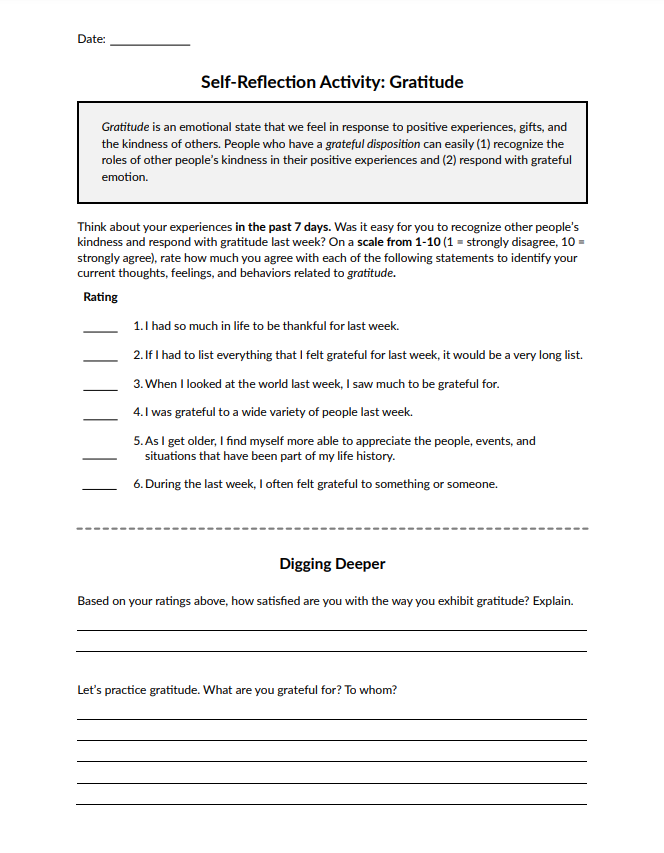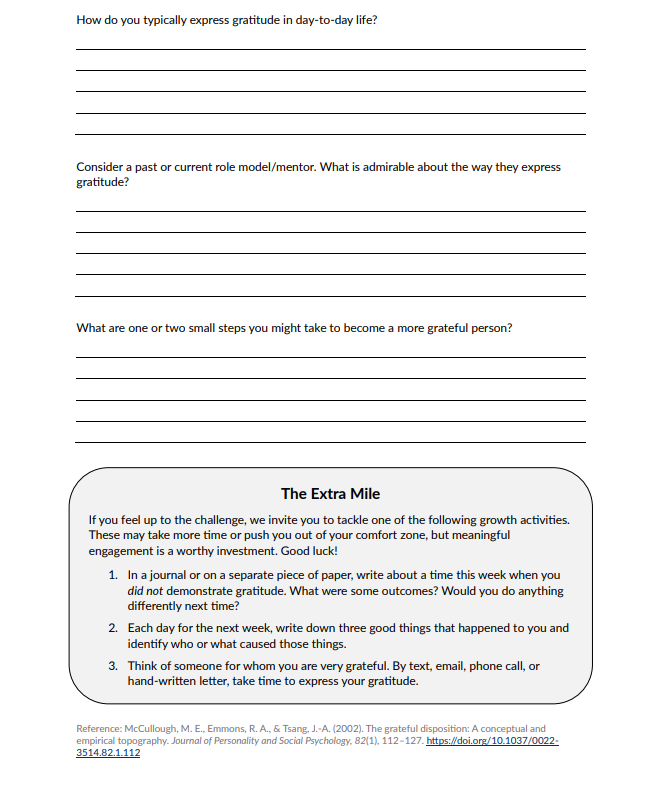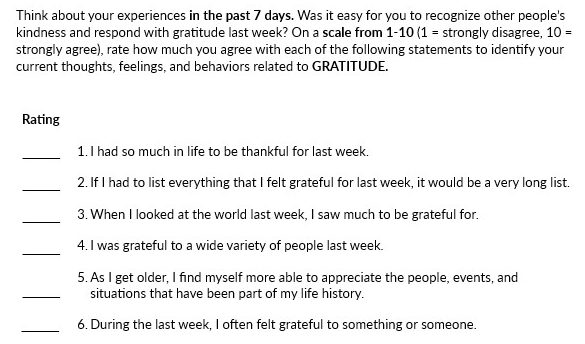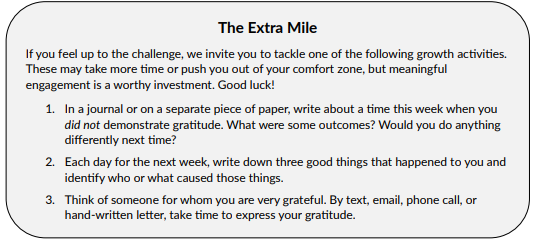Cultivating Character through Informal Assessment
7 Tool: Virtue Worksheets
Robert J. Ridder; Elizabeth M. Bounds; Karen K. Melton; and Sarah A. Schnitker
This chapter provides a series of virtue worksheets for individual self-reflection, which are designed to help your students think meaningfully about their own personal virtue development. Unlike the measurement tools in other chapters, these worksheets are designed only for personal reflection – they should not be used to evaluate your students, program, or organization.
In a previous chapter, we introduced an applied theory of virtue formation that entails the cyclical processes of knowing virtues, enacting them, and realigning oneself to incorporate virtue as a part of one’s identity. Each self-reflective virtue worksheet is designed to tap into these three components of virtue formation.
Although students can complete these worksheets on their own, you may wish to facilitate self-reflection as a group. For a helpful guide to facilitating these worksheets, refer to Chapter 6 – Guide: Personal Refelections via Virtue Worksheets . Also, please note that the top of each worksheet provides a space to record the date. This may be especially useful for recognizing change or development if your students complete the same worksheet multiple times during the course of their time in college.
Inside a Virtue Worksheet
The remainder of this chapter provides snapshots of an example worksheet with explanations of how each component taps into a process of KNOW, ENACT, and REALIGN. Throughout this chapter, we use the capitalized form of these words to connote the connection to the theory of virtue formation. For the purposes of this demonstration, we focus on the gratitude worksheet (Figures 7.1 and 7.2) as an example. Each worksheet is one page—back and front—and contains five unique sections—Definition, Self-Rating, Digging Deeper, and The Extra Mile.
Figure 7.1. Front of Worksheet 
Figure 7.2. Back of Worksheet

Definition Box
Each worksheet begins with a box that defines the topic virtue (KNOW) as seen in Figure 7.3. Of course, a few sentences do not suffice to provide an all-encompassing definition for something as complex as a virtue. But, along with the help of mentors and community, the definition box at the beginning of each worksheet can help jog your students’ memory as they begin their personal reflection. Refer to the guide for facilitating student self-reflection for ideas about how to expand on the short definitions each worksheet provides.
Figure 7.3. Definition Box

Self-Rating
Students will rate themselves on virtue statements adapted from preexisting scales developed based on the definition provided. Students are specifically prompted to think about their experiences from the past week and rate their own virtuous behavior on a scale from 1 (strongly disagree) to 10 (strongly agree) as seen in Figure 7.4. In addition to giving students examples of what the virtue looks like (KNOW), these statements should help students reflect on how they have ENACTED the virtue recently. If you or your students are interested in reading more about the development of these scale items, see the reference at the end of each worksheet.
Figure 7.4. Self-Rating

Alternative Timeframe. The worksheet provides the prompt “in the past 7 days;” however you can choose to tell students to consider the last month or semester, or any timeframe that you feel is more appropriate for your purposes in using these worksheets.
Digging Deeper
After rating their own virtuous behavior, students encounter the section of the worksheet titled, Digging Deeper (Figure 7.5), which encourages honest reflection by asking short journal questions. To begin Digging Deeper, students rate how satisfied they are with their 1-10 scale responses above. In asking this, we hope that they will begin the process of REALIGNMENT. For instance, if they are satisfied with their scores above, this can affirm their virtuous identity. If they are dissatisfied with their scores above, this reflection can provide an opportunity to think about what it might be like to grow in virtue.
Figure 7.5. Digging Deeper: Satisfaction

The subsequent Digging Deeper questions are designed to help students reflect on how they exhibit virtue, identify exemplary virtue in others, and consider how they might grow in virtue. Each virtue worksheet will contain slightly different questions, but they all target similar ideas. For example, the first two Digging Deeper questions presented in Figure 7.6 target the ENACT process, helping students practice gratitude and think of how they typically express gratitude day-to-day. Other common Digging Deeper questions ask students to think of how a role model expresses the topic virtue or what steps they can take to grow in virtue.
Figure 7.6. Digging Deeper: Self-Reflection

THE Extra Mile
The final section of each virtue self-reflection worksheet is titled The Extra Mile. The purpose of The Extra Mile is to challenge students to embody and practice each virtue more intentionally. Some prompts suggest extended reflective journaling (REALIGN), and others suggest action steps for virtue practice (ENACT). For example, in Figure 7.7 of the gratitude worksheet, we provide three Extra Mile activities:
Figure 7.7. The Extra Mile

The first activity shown here is common across many of our worksheets, asking students to reflect on a time when they did not act virtuously. This activity is intended to help students identify room for growth (after all, everyone has room to become more virtuous!). The next two activities are unique to the gratitude worksheet, both adapted forms of evidence-based interventions designed to increase gratitude. By encouraging the practice of virtues, we hope to help students build virtuous habits, embrace virtuous character, and integrate virtue as a core component of their identities.
Conclusion
Our virtue self-reflection worksheets are designed to help students identify the presence of virtue in their own lives as well as room for growth. In addition, each worksheet provides one or more avenues for practicing and developing virtue. Although these worksheets alone are unlikely to radically change a student’s moral identity, we hope that they will be helpful resources in your students’ journeys through knowing, enacting, and realigning themselves toward virtue. Also consider following up with some students with a personal conversation.
additional resources
Worksheet links
- Intellectual Humility
- Expressed Humility – Teachability
- Interpersonal Generosity
- Gratitude
- Gratitude to God
- Transcendent Indebtedness to God
- Transcendent Indebtedness to Humans
- Interpersonal Patience
- Life Hardships Patience
- Daily Hassles Patience
- Inhibitory Self-Control
- Initiatory Self-Control
- Courage
- Meaning in Life
- Beyond the Self Orientation
RELATED CHAPTERS
Habits of thinking, feeling, behaving, or relating that are consensually esteemed as morally good and reliably are contextually adaptive across time, cultures, and situations. In other words, character virtues are morally guided habits that contribute reliably to the flourishing of individuals and the social milieu in which they are embedded. Character virtues are characteristic adaptations of individuals and groups. Importantly, it is “coherence—the habit of doing the right thing at a specific place and a specific time—and not consistency [that] is the hallmark of character virtues" (Lerner, 2019). Once fully embodied and matured, character virtues reliably arise from an intrinsic (i.e., fully internalized) motivation (Ryan and Deci, 2000) and for the right reasons, particularly self-transcendent (i.e., beyond the self) motives and goals (Ratchford, Ming, and Schnitker, 2023).
“Systematic [internal] changes of [a person or group’s] behavior, and of the systems and processes underlying those changes and that behavior” (Overton, 2010).
an informal type of assessment used to collect and analyze personal information to make an informed decision for personal growth
an activity or set of activities that are grouped together for the purpose of achieving a specific outcome
A set of beliefs, values, affiliations, and roles a person uses to define their sense of self (“who I am”) and guide their decisions and behaviors (“how I live”). In short, an identity refers how a person self-defines who I am and how I live. An identity can also be communal, namely how a group of people collectively defines who we are and how we live (Oyserman, Elmore, Smith, 2012). See also meta-identity.
“[A disposition] to give a [particular] response in a particular context" (Wood, Labrecque, Lin, Rünger, 2014).
The set of beliefs, values, affiliations, and roles a person or group uses to define their ethically relevant sense of self and guide their ethically relevant decisions and behaviors.

Feedback/Errata